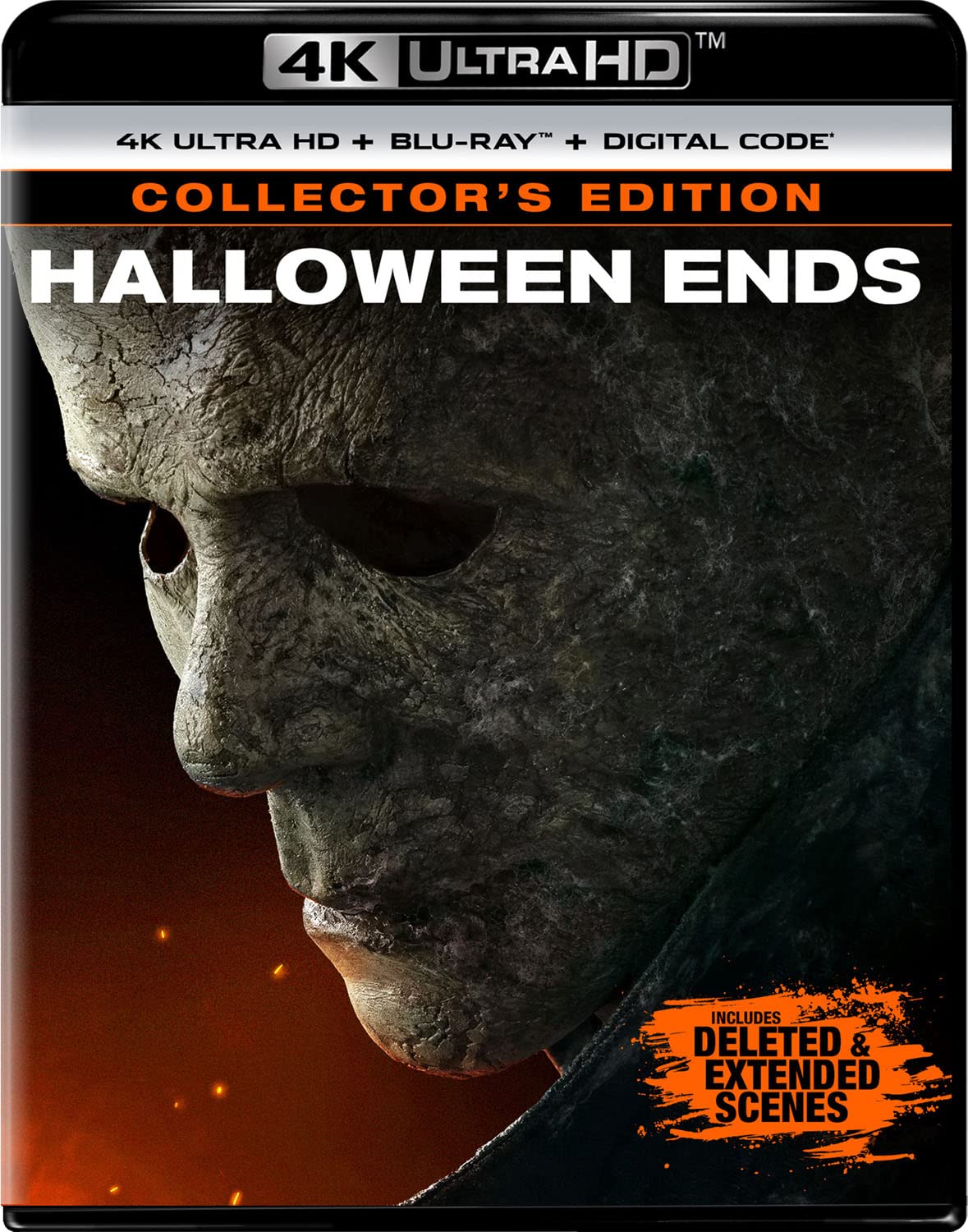
Halloween Ends (2022) – Collector’s Review Halloween Ends – Oemiu
Halloween Ends (2022) – A Collector’s Deep Dive: Is This Really the End?
The night he came home… again. And again. And again. Forty-four years after John Carpenter’s seminal slasher etched Michael Myers into the collective nightmares of a generation, David Gordon Green’s “Halloween Ends” promised a definitive conclusion to the saga of Laurie Strode and her seemingly unkillable tormentor. As collectors, we approach such momentous occasions with a mixture of excitement and trepidation. Excitement for the potential cinematic spectacle and closure, trepidation that the ending might not live up to decades of invested fandom. Did Halloween Ends deliver the satisfying resolution fans craved, or did it stumble on its final steps? Let’s delve deep into the film, examining its narrative choices, its visual style, and its overall impact on the legacy of Michael Myers, offering a comprehensive analysis tailored for discerning collectors and die-hard Halloween enthusiasts.
The Narrative Gamble: A Fresh Perspective or a Fatal Flaw?
“Halloween Ends” isn’t simply a retread of familiar slasher tropes. It dares to venture into uncharted territory, shifting the focus away from the immediate aftermath of “Halloween Kills” and instead exploring the lingering trauma of Haddonfield four years later. The town is a broken place, struggling to heal from the collective violence it has endured. This is where Corey Cunningham enters the picture, a young man ostracized and wrongly accused of a crime, bearing the weight of Haddonfield’s fear and suspicion. The film dedicates a significant portion of its runtime to Corey’s character arc, depicting his descent into darkness and his eventual connection to Michael Myers, who is lurking in the shadows, weakened but still a formidable force.
This narrative choice is undoubtedly the most divisive aspect of “Halloween Ends.” Some viewers appreciate the attempt to explore the cyclical nature of evil and the potential for ordinary individuals to become corrupted by trauma and societal pressure. They see Corey as a tragic figure, a victim of circumstance who is ultimately consumed by the same darkness that haunts Haddonfield. Others, however, criticize the film for sidelining Laurie Strode and Michael Myers in favor of Corey’s storyline. They feel that the film deviates too far from the core narrative and that Corey’s character arc feels forced and ultimately unsatisfying. This ultimately becomes a critique of this particular **Halloween Ends plot**.
The success of this narrative gamble hinges on whether the audience can empathize with Corey and accept him as a legitimate extension of the Halloween mythos. While Rohan Campbell delivers a compelling performance, capturing Corey’s vulnerability and descent into madness, the script struggles to fully integrate him into the larger narrative. The connection between Corey and Michael feels tenuous at times, and their relationship lacks the depth and complexity that could have elevated it beyond a simple transfer of evil. In many respects the **Halloween Ends ending** leaves much to be desired for longtime fans. Ultimately, the film’s willingness to take risks should be applauded, even if the execution falls short of its ambitious goals.
Laurie Strode’s Journey: From Victim to Vigilante to… Grandparent?
Laurie Strode has been the heart and soul of the Halloween franchise since its inception. From the terrified babysitter in the original film to the hardened survivalist in the recent trilogy, Laurie has evolved and adapted, embodying the resilience of the human spirit in the face of unimaginable evil. “Halloween Ends” attempts to provide Laurie with a sense of closure, depicting her as a woman who has finally found peace and purpose in the aftermath of her traumatic experiences. She is writing a memoir, attempting to make sense of her past and to reclaim her narrative. She is also fostering a close relationship with her granddaughter, Allyson, offering her guidance and support as she navigates the challenges of young adulthood.
However, this portrayal of Laurie as a nurturing and serene figure feels somewhat jarring, especially considering the events of the previous films. While it is understandable that Laurie would seek to find peace and happiness after decades of fear and trauma, the film struggles to convincingly portray this transformation. Her transition from a hardened warrior to a benevolent grandmother feels rushed and underdeveloped, leaving the audience to question whether she has truly healed from her past. This can be seen by many as a jarring change from other **Halloween Ends sequels**.
Despite these shortcomings, Jamie Lee Curtis delivers a powerful and nuanced performance, imbuing Laurie with a quiet strength and resilience. She shines in the scenes where Laurie confronts her own demons and grapples with the legacy of Michael Myers. Her final showdown with Michael, while somewhat anticlimactic, provides a fitting culmination to their decades-long conflict, allowing Laurie to finally exorcise the demons that have haunted her for so long. However, the fact that she is arguably sidelined for a significant portion of the film is a disservice to her character and to the fans who have followed her journey for over four decades.
Michael Myers: The Shape in the Shadows, Diminished but Still Deadly
Michael Myers, the embodiment of pure evil, has been the boogeyman of our nightmares for over four decades. In “Halloween Ends,” Michael is depicted as a weakened and diminished figure, lurking in the sewers of Haddonfield, seemingly waiting for an opportunity to strike again. He is no longer the unstoppable force of nature he once was, but he is still a formidable threat, capable of inflicting unimaginable violence.
The film explores the idea that Michael Myers is not merely a man, but an embodiment of evil that can be transferred to others. This is evident in his connection to Corey Cunningham, who becomes increasingly influenced by Michael’s darkness. The film suggests that evil is not something that can be eradicated, but rather something that is cyclical and persistent, always lurking beneath the surface of society.
However, the portrayal of Michael in “Halloween Ends” is perhaps the most disappointing aspect of the film. He is relegated to a supporting role for much of the runtime, his presence felt more than seen. His appearances are brief and often underwhelming, lacking the visceral impact and terror that have defined his character. While the film attempts to explain his diminished state, it ultimately fails to deliver a satisfying portrayal of the iconic boogeyman. His final confrontation with Laurie feels rushed and anticlimactic, failing to live up to the expectations of fans who have waited decades to see their final showdown. Ultimately, Michael’s diminished role and the shifting focus to Corey Cunningham, a new character, leaves the audience questioning the purpose of the **Halloween Ends movie** as a true finale to the story.
Visuals, Sound, and Atmosphere: A Return to Form?
Visually, “Halloween Ends” is a return to the atmospheric style of John Carpenter’s original film. The cinematography is stark and unsettling, capturing the bleak and desolate landscape of Haddonfield. The use of shadows and darkness creates a sense of dread and suspense, reminding us that evil can lurk anywhere, even in the most ordinary of places. The film also features some inventive and brutal kills, showcasing the violence that has become synonymous with the Halloween franchise.
The score, composed by John Carpenter, Cody Carpenter, and Daniel Davies, is another highlight of the film. It pays homage to the iconic themes of the original film while also incorporating new and unsettling sounds that reflect the film’s darker tone. The score effectively enhances the atmosphere of dread and suspense, creating a truly immersive and terrifying viewing experience. The sound design, similarly, excels. The use of silence punctuated by sharp, jarring noises effectively builds tension and keeps the audience on the edge of their seats.
However, these elements can only carry the film so far. The atmospheric visuals and unsettling score cannot compensate for the shortcomings of the narrative and the underwhelming portrayal of Michael Myers. While the film strives to capture the essence of the original Halloween, it ultimately falls short of its goals, leaving the audience feeling underwhelmed and unsatisfied.
| Feature | Description |
|---|---|
| Narrative Focus | Shifts focus to Corey Cunningham and the town’s trauma, sidelining Michael Myers for a significant portion. |
| Laurie Strode’s Arc | Attempts to provide closure, depicting her as a peaceful grandparent, but feels rushed. |
| Michael Myers’ Portrayal | Depicted as weakened and diminished, lacking the terror of previous installments. |
| Visuals and Sound | Atmospheric cinematography and unsettling score create a sense of dread and suspense. |
| Overall Impact | Divisive, with some appreciating the narrative risks and others criticizing the deviation from the core story. |
FAQ
Is “Halloween Ends” really the end of the Halloween franchise?
While “Halloween Ends” is marketed as the final chapter in the saga of Laurie Strode and Michael Myers, the history of the Halloween franchise suggests that it is unlikely to be the true end. The horror genre is known for its remakes, reboots, and sequels, and the enduring popularity of Michael Myers makes him a prime candidate for future iterations. Even if this particular storyline is concluded, it is highly probable that another filmmaker will eventually attempt to reimagine the Halloween mythos for a new generation of audiences. The ending itself leaves some room for interpretation, suggesting that the evil of Michael Myers could potentially be transferred to another individual, opening the door for future sequels or spin-offs. So, while we may have seen the last of this particular iteration of Laurie and Michael, the spirit of Halloween is likely to live on in some form.
What are the main criticisms of “Halloween Ends”?
The primary criticism of “Halloween Ends” revolves around its narrative choices. Many viewers felt that the film deviated too far from the core story of Laurie Strode and Michael Myers, instead focusing on the character of Corey Cunningham. This shift in focus left many fans feeling disappointed and underserved, particularly those who were expecting a final showdown between Laurie and Michael. Another common criticism is the portrayal of Michael Myers as a weakened and diminished figure. Many felt that he lacked the terror and menace of previous installments, and that his final confrontation with Laurie was anticlimactic. Additionally, some viewers felt that the film’s attempts to explore the cyclical nature of evil and the potential for ordinary individuals to become corrupted were heavy-handed and ultimately unsatisfying. The film does attempt to provide a definitive **Halloween Ends conclusion**, but for many viewers the conclusion misses the mark.
How does “Halloween Ends” compare to the other films in the David Gordon Green trilogy?
“Halloween Ends” differs significantly from the other two films in the David Gordon Green trilogy. “Halloween” (2018) served as a direct sequel to the original 1978 film, offering a nostalgic and visceral return to the classic slasher formula. “Halloween Kills” (2021) ramped up the violence and explored the collective trauma of Haddonfield, depicting a town consumed by fear and rage. “Halloween Ends,” in contrast, attempts to explore more complex themes and introduce new characters, but it ultimately struggles to balance these elements with the expectations of long-time fans. While all three films share a similar visual style and a commitment to honoring the legacy of John Carpenter’s original, “Halloween Ends” is the most divisive and arguably the least successful of the trilogy.
Does “Halloween Ends” offer any resolution to Laurie Strode’s story?
Yes, “Halloween Ends” does attempt to provide some resolution to Laurie Strode’s story. The film depicts her as a woman who has finally found peace and purpose after decades of trauma and fear. She is writing a memoir, attempting to make sense of her past and to reclaim her narrative. She is also fostering a close relationship with her granddaughter, Allyson, offering her guidance and support. Her final confrontation with Michael Myers, while somewhat anticlimactic, allows her to finally exorcise the demons that have haunted her for so long. However, some viewers may find this resolution unsatisfying, particularly given the events of the previous films and the fact that Laurie is arguably sidelined for a significant portion of the film.
What is the significance of Corey Cunningham’s character in “Halloween Ends”?
Corey Cunningham represents the cyclical nature of evil and the potential for ordinary individuals to become corrupted by trauma and societal pressure. The film suggests that evil is not something that can be eradicated, but rather something that is persistent and can be transferred to others. Corey, a young man ostracized and wrongly accused of a crime, becomes increasingly influenced by Michael Myers’ darkness, ultimately becoming a vessel for his evil. His character arc serves as a cautionary tale, highlighting the dangers of unchecked anger, fear, and societal prejudice.
Was “Halloween Ends” a financial success?
“Halloween Ends” was a moderate financial success, grossing over $100 million worldwide on a budget of around $20 million. However, its box office performance was significantly lower than that of “Halloween” (2018) and “Halloween Kills” (2021), likely due to the negative critical reception and the divisive nature of the film. The simultaneous release of the film in theaters and on streaming platforms may have also contributed to its lower box office numbers.
What is the overall legacy of the David Gordon Green Halloween trilogy?
The David Gordon Green Halloween trilogy is a mixed bag in terms of its legacy. “Halloween” (2018) was generally well-received, praised for its nostalgic tone and its return to the classic slasher formula. “Halloween Kills” (2021) was more divisive, with some appreciating its exploration of the collective trauma of Haddonfield and others criticizing its excessive violence and lack of narrative coherence. “Halloween Ends” (2022) was the most controversial of the trilogy, with many viewers criticizing its narrative choices and its portrayal of Michael Myers. Despite its flaws, the trilogy as a whole has contributed to the ongoing legacy of the Halloween franchise, introducing the iconic boogeyman to a new generation of audiences and sparking renewed interest in the original films. The **Halloween Ends reviews** are varied to say the least.




Price: $22.99 - $12.99
(as of Sep 06, 2025 09:09:34 UTC – Details)



![Scary Stories To Tell In The Dark [DVD]](https://oemiu.com/wp-content/uploads/2025/09/1757427628_Scary-Stories-To-Tell-In-The-Dark-DVD-Review-Best-336x220.jpg)
